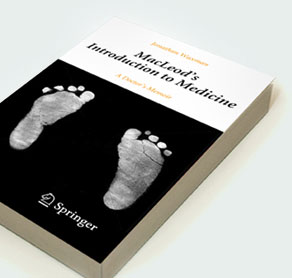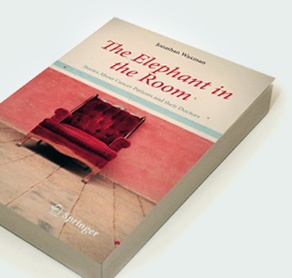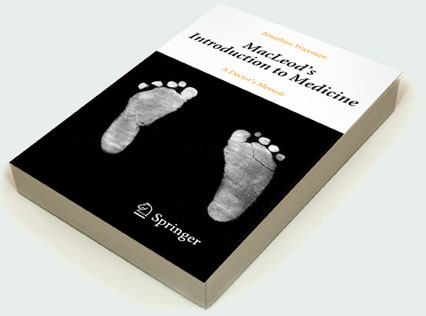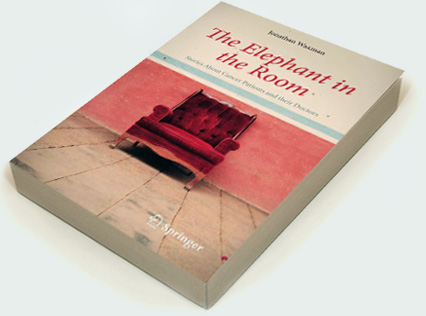The books: MacLeod’s Introduction to Medicine
![]() Sir Valentine Jenkinson-Smythe was a surgeon carved in the most traditional style. His early education at Harrow, where he was head boy, had been the prelude to First Class honours at Cambridge, where he was a rowing Blue. Cambridge was followed by a glorious medical school career at St Thomas’s Hospital. Postgraduate success billowed and bulged, and he travelled on a Royal College of Surgeons’ fellowship to Yale where his research on biliary obstruction was acclaimed on the international surgical stage. He specialised in gynaecology and his career blossomed. In his very early thirties he was appointed consultant gynaecologist to St Bartholomew’s Hospital. He became a Freemason and his private practice flourished. He married well, to a gal of good family and even better fortune, and in time was appointed surgeon accoucheur to her Majesty, about whose private apartments he was most discreet.
Sir Valentine Jenkinson-Smythe was a surgeon carved in the most traditional style. His early education at Harrow, where he was head boy, had been the prelude to First Class honours at Cambridge, where he was a rowing Blue. Cambridge was followed by a glorious medical school career at St Thomas’s Hospital. Postgraduate success billowed and bulged, and he travelled on a Royal College of Surgeons’ fellowship to Yale where his research on biliary obstruction was acclaimed on the international surgical stage. He specialised in gynaecology and his career blossomed. In his very early thirties he was appointed consultant gynaecologist to St Bartholomew’s Hospital. He became a Freemason and his private practice flourished. He married well, to a gal of good family and even better fortune, and in time was appointed surgeon accoucheur to her Majesty, about whose private apartments he was most discreet.
With time, the svelte rowing Blue became a more substantial figure. Now, in his early sixties V J-S, as he was known to his colleagues, was portly and plethoric, his girth and complexion a product of fine dinners and fabulous wines, his stature at once reassuring and majestic. There was no one he reminded one of so much as George VI. In many ways, he was so like the king in manner, he lacked only an ermine robe for completion of the likeness.
V J-S was assiduous in the pursuit of his private practice, deigning only to descend to his NHS commitments at Barts in quiet moments when the grouse season was closed. In the evening, he could be found at his club, the Carlton, if anyone wanted to discuss medical school matters, but he retained his membership of the Reform for social events. He was a fierce clinical teacher who many thought had styled himself on the grandees of Doctor in the House. However, it is just as possible that Richard Gordon modelled Sir Lancelot Spratt on VJ-S. In a time when watch chains were unfashionable and when there were concerns about contagion in the wards, V J-S wore a chain across his pinstriped waistcoat and wore a carnation in his buttonhole. He also tramped through the hospital on his rounds wearing riding boots caked with mud.
If it had been possible to have a horse-drawn carriage take him to work, V J-S would have had one and it was to his chagrin that there was no stabling at Barts. V J-S made do with a Rolls-Royce instead of a carriage, and he took pleasure in driving the car himself. The Rolls was parked in the main square at Barts, where neither pigeon nor starling dared desecrate its polished carriage work.
‘One would not have a chauffeur,’ he boomed at a colleague, ‘Not with a Rolls … but I would consider it, if I had a Bentley. Tell me, old chap, who of any breeding would have a Bentley?’
Chapter One - The Grandest Surgeon
MacLeod's Introduction to Medicine: A Doctor's Memoir was published by Springer on 30th September 2013.

Buy the book
MacLeod's Introduction to Medicine was published by Springer on 30.09.13 and is available from all good bookshops, including:
Blackwell WHSmith Waterstone's AmazonThe books: The Elephant in the Room
![]() This book started life as a conversation between the writer J G Ballard and his doctor. I was his doctor. The conversations were to be about life and death.
This book started life as a conversation between the writer J G Ballard and his doctor. I was his doctor. The conversations were to be about life and death.
Jimmy had prostate cancer, and the plan for the book had reached a point where an outline had been sketched and the content planned. I had put to Jimmy the concept of a project about cancer. I had suggested the idea of a jointly written book based around the relationship between a patient and his specialist. Jimmy and I were hugely excited about the idea of the book. We intended to spend time together talking about the impact of cancer on his life, what it really meant to be a patient, the interactions between doctors and patients, what the doctor and the patient really thought about, and what the doctor really meant when he spoke to patients. This exchange was to be bound by a thread that took in our journeys through life. It was to be a contemporaneous account of two lives intertwined and interlinked.
So, that's what had been planned, and the plan was bound to extend beyond its loosely set outlines and borders.
Jimmy set about writing a book proposal but before our project could be realised, darkness struck, and Jimmy became too poorly to think about writing. And so the book was never written, and the proposal languished in my filing cabinets until the moment of Jimmy's memorial service. This celebration of Jimmy's life was held on the top floor of the Tate, with great views over the Thames, exotic canapés, and a gathering of friends and family. We sat together, listening to speeches that brought together all the parts of Jimmy's world, speeches from Jimmy's wonderful daughters, writers, friends, film producers, and the marvellously self-effacing, baseball-hat-wearing Stephen Spielberg.
As Jimmy's doctor, I had been invited to close with a tribute to Jimmy. At the end of my talk, as I stood in sunlight at the lectern, I was left with the feeling that somehow I'd let Jimmy down by not completing our project.
I'd had a history with Jimmy that antedated his illness. We had met many years before he was ill, when I had looked after one of his dear friends who had breast cancer. That was in the 1990s, and I had just completed work on my third and as yet unpublished novel, to write was my big dream.
I decided to exploit the contact that had been made with Jimmy. I asked him to read my book. I put the book in the post, and sent it to him on a Friday for comments, with apologies for imposing on him. He read my book over the weekend, and I received a blue biro letter from him on the Tuesday morning, expressing interest, and suggesting that he might send the book to his agent Margaret Hanbury, if I would allow him to do so. Well, of course I would allow him to do so, and the introduction led to the publication of my first novel, an event ranking a great deal below the arrival of children in consequence, but still of some enormous excitement to me.
Events in my own life took a poor turn, and creativity took second place. In the place where I earned a living I met Jimmy again. He had become poorly and I was so pleased to be able to help him as he had helped me. He was transformed by treatment. From being dreadfully sick and in considerable pain, he became remarkably well and produced Miracles of Life.
When in remission of his cancer, Jimmy would come to clinic every month and, on many occasions he would ask me about my writing and, caring for his doctor, he would gently tell me that I really should get writing again. He'd say, "You really should, you know."
And his right hand would give emphasis to his comment with a curving karate chop that cut the cold consulting room air and entirely froze all conversation.
These exchanges caused me great discomfort. Some of the discomfort was due to the fact that I was not being creative, and possibly could be, and the rest of the discomfort was due to the fact that I couldn't break the barrier of patient-doctor relationship to explain to him the reasons why I could not be creative. I wished somehow that I could break the barrier, and explain to him why it was that I had failed to come up to standard and produced another little effort.
I looked again at our outline after the memorial service, and felt that some how and in some way the outline was his gift to me, the stimulus for a book on cancer. With his loss our collaboration could never be realised, what had been conversation was now a monologue. In its creation this book comes from my life as a cancer doctor, its errors and idiocies are mine, and my intentions and ambitions are to explain and guide.
I have written about the patient and his cancer and described what the doctor feels, described what the doctor really thinks as he talks to his patient. The faults and fractures in these stories are mine, but I have done my best for the love of a great man.”
Professor Jonathan Waxman - Preface
The Elephant in the Room: Stories about Cancer Patients and their Doctors was published by Springer on 31st October 2011.

Buy the book
The Elephant in the Room was published by Springer on 31.10.11 and is available from all good bookshops, including:
Blackwell WHSmith Waterstone's AmazonThe books: The Fifth Gospel
The Fifth Gospel was published pseudonymously by Macmillan in 1996 and is the ultimate conspiracy story, describing the manipulation of society by the Vatican. The story is related by an insider in the Vatican. The book’s theme is the history of world and in relating this theme, the book shows how the Catholic Church abused and exploited Christianity in order to maintain power. It is only now that we see how prescient this book was, as the various scandals with which the church has been embroiled have been exposed.
The Fifth Gospel was published by Macmillan in 1996.

